It looks like you're using an Ad Blocker.
Please white-list or disable AboveTopSecret.com in your ad-blocking tool.
Thank you.
Some features of ATS will be disabled while you continue to use an ad-blocker.
share:
Good evening and welcome to my 3rd and final part of the small series I've done on Korea. I hope what I've been able to put together and present is
helpful and adds to the overall knowledge and perspective for watching the events on the Korean Peninsula play out.
This thread is the longest and by a fair margin. It is also the most informative. The first two (Status and Geography) have built the groundwork for putting all of this into context. This part is what I know everyone has been most interested in.
I certainly learned quite a bit myself while making it. That has been part of the time consuming nature of this. It's so multi-layered a topic with so many different moving parts, so to speak, it takes a good deal of work to do more than learn, but place in proper perspective and make it meaningful.
- This thread IS NOT a place where you'll find juicy or even interesting data about American, Allied or ROK commands, forces or strategy beyond what may be widely distributed and speculated on in open media now. I'm not trying to present balance where that area is concerned and this statement is here to clarify that. What I am doing is presenting the summary of the military in a closed and isolated nation we may well be at war with. In the end, I'm American and in time of war, my loyalty is without question or compromise, to my nation. It may or may not be to my Government. However, my nation always comes first. Just so that is said at the outset.
Now on to the big juicy steak dinner I know people are opening this up to find
Well, where else to start in looking at a nation's potential to cause murder and mayhem than to first look at the tools they have to do it. In this first section, we'll simply look at a broad overview of what North Korea is thought or known to have. Each area will get far greater attention later.
* Aircraft *
Bombers: 80
Fighters: 541
Transports: 361
Transport Helicopters: 588
Attack Helicopters: 24
Trainers: 228
* Armor *
Main Tanks: 3,500
Light Tanks: 560
Armored Carriers: 2,500
Towed Artillery: 3,500
Self-Propelled Artillery: 4,400
MLRS (Multiple Launch Rockets): 2,500
* Naval Forces *
Submarines: 92
Frigates: 3
Corvettes: 6
Missile Boats: 43
Large Patrol Craft: 158
Fast Torpedo Craft: 103
Misc Patrol Craft: 334
Amphibious Ships: 10
Coastal Defense Batteries: 2
Hovercraft: 130
Minesweeper: 23
Midget Ships: 8
* Heavy Weapons *
Mortars: 7,500
Recoilless Rifles: 1,700
Air Defense Guns: 11,000
* Personnel *
Total: 1.17 Million
Special Forces: 87,000
Navy: 60,000
Air Force: 110,000 (includes 7,000 Special Mission capable)
Reserves: 7.7 Million (620,000 assigned to training units / 420,000 in paramilitary units - Remainder are workers and Peasants Red GUard or Red Guard Youth)
The above numbers are source from the Library of Congress, Federal Research Division and were presented to members of the United States Congress in July of 2007.
This source is Globa l Firepower and shows the same numbers in some, wildly different in others and yet more that might leave you wondering if we're talking about the same country at all. (We won't even touch what Wikipedia adds just for the fun of total confusion.)
Here is the first lesson to absorb, as I discovered after great hand wringing and stress over getting accurate numbers. THERE AREN'T ANY.. In many areas, it's guess work, satellite imagery analysis and plain old debriefing of defectors who may or may not have ulterior motives or faulty memories. In many categories of land and sea based weapons, this is as authoritative a summary as one is likely to get. I will simply say, it's close. ALL sources, from all directions agree on the KEY points of those numbers. What isn't usually added is what I will add now.
Those numbers are deceiving. While precise count by tank turret or aircraft in a hangar isn't possible with certainty, it IS a certainty to say that among what is being counted are relics from the last Korean War and other obsolete equipment. As many as 2,000 old Type 59 tanks may still be in service. That is a tank that began production in 1958!
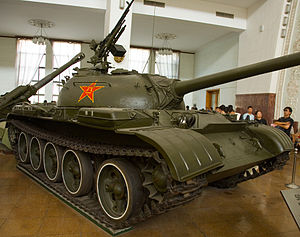
(Type 59 in a museum, courtesy of Wiki)
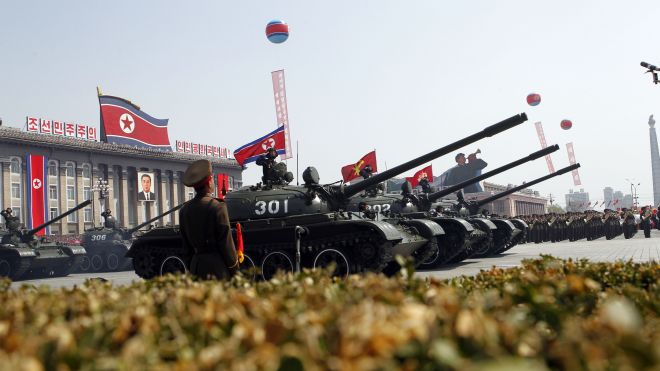
(Type 59's on parade, Pyongyang - DPRK)
Among the aircraft in those enormous numbers above are things like this:
MD 500D (Acquired from Germany)
 (Estimate at over 80+ - Image from Wiki)
(Estimate at over 80+ - Image from Wiki)
Shenyang F-5
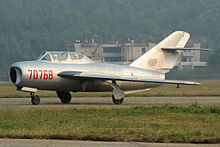 (Estimates over 100 - Image from Wiki)
(Estimates over 100 - Image from Wiki)
and finally, their strategic bomber....or at least a model from the same series of aircraft.
Il-28 / H-5
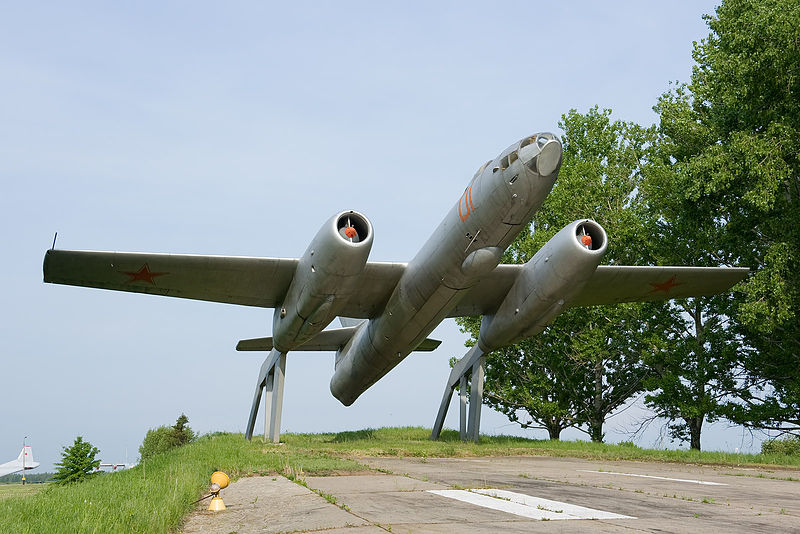 (Estimates at 80 - Image from Wiki)
(Estimates at 80 - Image from Wiki)
The bottom line on these systems and the garden variety military equipment is that no one knows for certain. Many sites claim to and most conflict in numbers ..or PRECISELY copy each other on them. As I'll cover, a good part of North Korea's manufacturing base, storage and military is housed underground and in some of the most extensive tunneling in the world.
This thread is the longest and by a fair margin. It is also the most informative. The first two (Status and Geography) have built the groundwork for putting all of this into context. This part is what I know everyone has been most interested in.
I certainly learned quite a bit myself while making it. That has been part of the time consuming nature of this. It's so multi-layered a topic with so many different moving parts, so to speak, it takes a good deal of work to do more than learn, but place in proper perspective and make it meaningful.
______________________________
A quick note about what this thread is and is not.
- This IS a thread covering a great deal of information about the military history (as it relates), development and deployment of the armed forces in North Korea. It's a thread with information to stand as reference material as well as data that won't help anyone sleep any better. At the same time, other areas will help some understand that areas of the threat are badly sensationalized in the media. It's all a matter of, quite literally, where you stand in relation to North Korea.- This thread IS NOT a place where you'll find juicy or even interesting data about American, Allied or ROK commands, forces or strategy beyond what may be widely distributed and speculated on in open media now. I'm not trying to present balance where that area is concerned and this statement is here to clarify that. What I am doing is presenting the summary of the military in a closed and isolated nation we may well be at war with. In the end, I'm American and in time of war, my loyalty is without question or compromise, to my nation. It may or may not be to my Government. However, my nation always comes first. Just so that is said at the outset.
Now on to the big juicy steak dinner I know people are opening this up to find
______________________________
* General Summary *
Well, where else to start in looking at a nation's potential to cause murder and mayhem than to first look at the tools they have to do it. In this first section, we'll simply look at a broad overview of what North Korea is thought or known to have. Each area will get far greater attention later.
* Aircraft *
Bombers: 80
Fighters: 541
Transports: 361
Transport Helicopters: 588
Attack Helicopters: 24
Trainers: 228
* Armor *
Main Tanks: 3,500
Light Tanks: 560
Armored Carriers: 2,500
Towed Artillery: 3,500
Self-Propelled Artillery: 4,400
MLRS (Multiple Launch Rockets): 2,500
* Naval Forces *
Submarines: 92
Frigates: 3
Corvettes: 6
Missile Boats: 43
Large Patrol Craft: 158
Fast Torpedo Craft: 103
Misc Patrol Craft: 334
Amphibious Ships: 10
Coastal Defense Batteries: 2
Hovercraft: 130
Minesweeper: 23
Midget Ships: 8
* Heavy Weapons *
Mortars: 7,500
Recoilless Rifles: 1,700
Air Defense Guns: 11,000
* Personnel *
Total: 1.17 Million
Special Forces: 87,000
Navy: 60,000
Air Force: 110,000 (includes 7,000 Special Mission capable)
Reserves: 7.7 Million (620,000 assigned to training units / 420,000 in paramilitary units - Remainder are workers and Peasants Red GUard or Red Guard Youth)
The above numbers are source from the Library of Congress, Federal Research Division and were presented to members of the United States Congress in July of 2007.
This source is Globa l Firepower and shows the same numbers in some, wildly different in others and yet more that might leave you wondering if we're talking about the same country at all. (We won't even touch what Wikipedia adds just for the fun of total confusion.)
Here is the first lesson to absorb, as I discovered after great hand wringing and stress over getting accurate numbers. THERE AREN'T ANY.. In many areas, it's guess work, satellite imagery analysis and plain old debriefing of defectors who may or may not have ulterior motives or faulty memories. In many categories of land and sea based weapons, this is as authoritative a summary as one is likely to get. I will simply say, it's close. ALL sources, from all directions agree on the KEY points of those numbers. What isn't usually added is what I will add now.
Those numbers are deceiving. While precise count by tank turret or aircraft in a hangar isn't possible with certainty, it IS a certainty to say that among what is being counted are relics from the last Korean War and other obsolete equipment. As many as 2,000 old Type 59 tanks may still be in service. That is a tank that began production in 1958!

(Type 59 in a museum, courtesy of Wiki)

(Type 59's on parade, Pyongyang - DPRK)
Among the aircraft in those enormous numbers above are things like this:
MD 500D (Acquired from Germany)

Shenyang F-5

and finally, their strategic bomber....or at least a model from the same series of aircraft.
Il-28 / H-5

The bottom line on these systems and the garden variety military equipment is that no one knows for certain. Many sites claim to and most conflict in numbers ..or PRECISELY copy each other on them. As I'll cover, a good part of North Korea's manufacturing base, storage and military is housed underground and in some of the most extensive tunneling in the world.
If you looked at the summary section and got to thinking that maybe North Korea isn't so big a deal afterall? Well, I can understand the sentiment.
In this section, I'm dealing with Aircraft and Air Defense. The Aircraft in the summary section are ...well...laughable by today's standards. South
Korea has state of the art F-16 and F-15 fighter aircraft, among other things. Many other things. The Air force of the DPRK would last minutes in
engagements, where they dare take off in the first place.
This doesn't necessarily mean they are toothless and without modern weapons though. That is where nothing relating to North Korea is as easy as it first looks.
First, lets get the overall list out of the way and remember what I said about accuracy.....it's important to note.
Korean People's Air Force (It's Wiki..but they have the full list of everything with citations to support most of it)
I'm not interested in showing his relics and museum pieces though and they comprise the vast majority of total aircraft he's got. Not ALL...however he has some advanced systems.
MiG - 29 Fulcrum
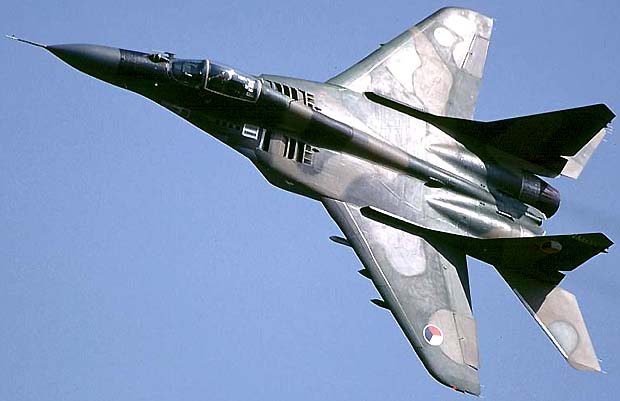 (Estimate: 40 - Source)
(Estimate: 40 - Source)
SU-25
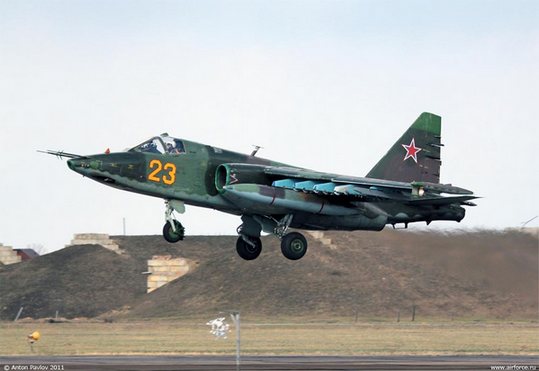 (Estimate - 36 - Source)
(Estimate - 36 - Source)
MiG-23 Flogger
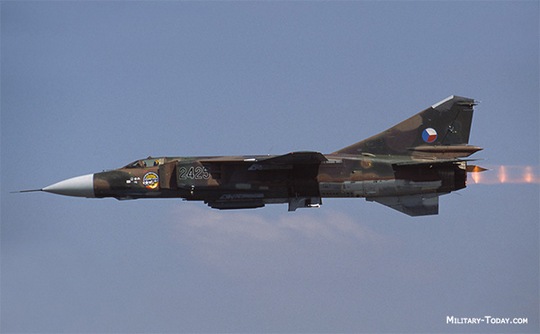 (Estimate - 40 - Source)
(Estimate - 40 - Source)
Now those can be some formidable airplanes. They absolutely can. Other things? Well... Less so. Let's see what they consider Stealth in North Korea?
Antonov An-2 Colt
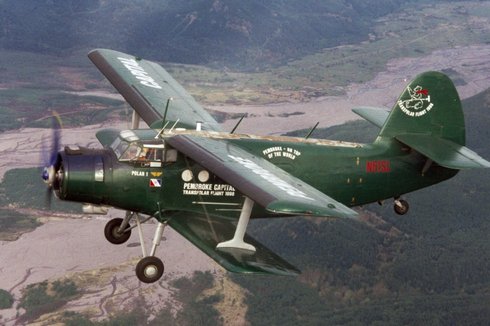
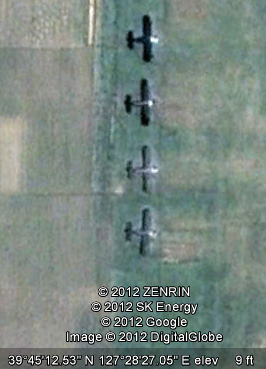
(Estimate: Unknown - Source: See Below Text)
I'm not even going to attempt to explain... I'll let an this article give it a shot.
(Sourcing for above data and other information in thread)
Hmmm... A colt Vs a....
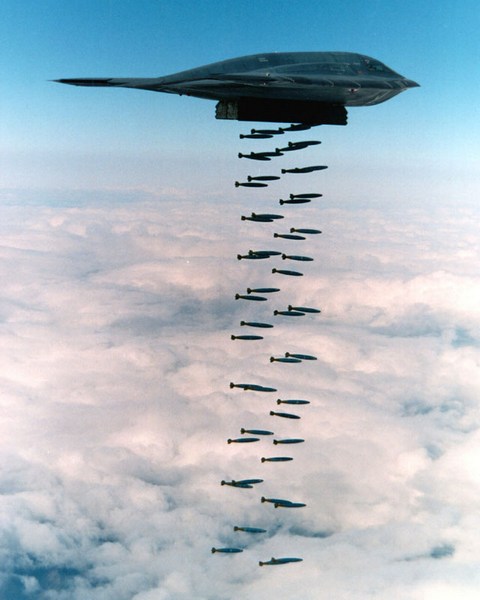
Well.. I do wish him luck with that. China or Russia may give a B-2 crew reason to sweat bullets if they flew missions into those nations. However, North Korea is probably not the largest threat for an Air Force.
Although, improving ...It simply makes me worry about his motives and sense of build-up to action, not a threat BY that action. Not here.
This is where Kim has been planning and building to this for a lot longer than just a few weeks or couple months here recently. He's had more in mind than just a big diplomatic dust up, IMO.
Additional: N.Korea Steps Up Air Force Training Flights
This doesn't necessarily mean they are toothless and without modern weapons though. That is where nothing relating to North Korea is as easy as it first looks.
* Air Force or Air Farce? *
First, lets get the overall list out of the way and remember what I said about accuracy.....it's important to note.
Korean People's Air Force (It's Wiki..but they have the full list of everything with citations to support most of it)
I'm not interested in showing his relics and museum pieces though and they comprise the vast majority of total aircraft he's got. Not ALL...however he has some advanced systems.
MiG - 29 Fulcrum

SU-25

MiG-23 Flogger

Now those can be some formidable airplanes. They absolutely can. Other things? Well... Less so. Let's see what they consider Stealth in North Korea?
Antonov An-2 Colt


(Estimate: Unknown - Source: See Below Text)
I'm not even going to attempt to explain... I'll let an this article give it a shot.
Although many of its aircraft would not look out of place in aviation history museums, this does not mean that some of the older aircraft types do not have significant tactical value. One such aircraft is the Soviet built Antonov AN-2 (introduced 1947), the largest biplane ever designed. Capable of carrying at least 12 paratroopers, the AN-2’s biplane design has many interesting advantages, being able to take off and land on rough surface runways from very short distances (just 560ft required), fly very slowly (the stall speed is just 30mph), and as a result of its low speed flight capability, fly safely at extremely low altitude. Interestingly, its light airframe, canvas skin and single propeller engine also give it a surprisingly high degree of stealth capabilities.
(Sourcing for above data and other information in thread)
Hmmm... A colt Vs a....

Well.. I do wish him luck with that. China or Russia may give a B-2 crew reason to sweat bullets if they flew missions into those nations. However, North Korea is probably not the largest threat for an Air Force.
Chronic fuel shortages have meant that pilots have been reported to have as little as 20 hours training per year, giving them little experiencing in either defensive or offensive aerial flight. In addition, North Korea’s moribund economy has meant it has long been unable to purchase modern jets of any substantial quantity, a problem that will continue even if the economic situation improves due to UN sanctions that prevent the legitimate sale of modern fighter jets. And while theoretically possessing a large air force, much of the equipment has been shown by satellite images to be in a state of decay, with inventory often stripped of parts, left in un-flyable condition.
Although, improving ...It simply makes me worry about his motives and sense of build-up to action, not a threat BY that action. Not here.
(Source Above)
Following the death of Kim Jong-il, several reports emerged which said that the North Korean air force was flying far more training missions than was normal. During winter up to 650 training flights per day were recorded, well up from the 100 or so average throughout 2011. The training flights in the earlier part of 2012 were also reportedly more antagonistic than usual, with DPRK forces flying so close to the DMZ that South Korean Air Force reportedly had to scramble aircraft several times in response. These training flights also employed North Korea’s best inventory, its fleet of MiG-29 fighter jets and SU-25 close-air-support jets
This is where Kim has been planning and building to this for a lot longer than just a few weeks or couple months here recently. He's had more in mind than just a big diplomatic dust up, IMO.
Additional: N.Korea Steps Up Air Force Training Flights
Well, Air Force naturally leads into Air Defense for just a moment. North Korea has Anti-Air defense split into two main segments. It's Anti-Air
Artillery and Guns with it's Anti-Air Missiles. First, the guns.
Unfortunately, this is yet another area where you can ask 10 world experts and you will get at least 6 totally different and unrelated answers for inventory number. None will match and ALL will insist to their dying breath that they are 150% right and the other 5 are flat wrong.
We DO know WHAT they have though, as satellites are always watching. By the very nature of the systems, they cannot hide everything, all the time ....or it's as useless as the museum pieces they bear such a resemblence to.
* Self Propelled AA Guns *
ZSU 23
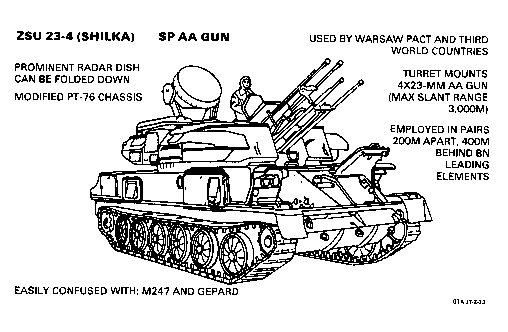
(Estimated - ? - FAS Graphic)
ZSU - 57
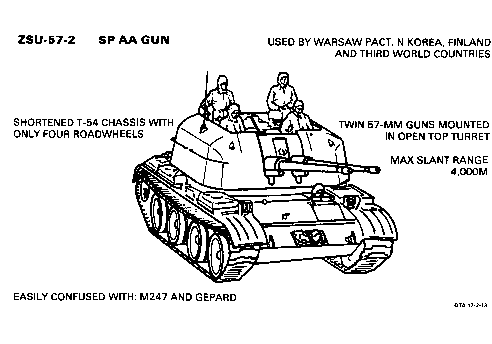
(Estimated - ? - FAS Graphic)
The ZSU's are deviously effective weapons systems, despite their old and low tech appearance. In fact, it's this low tech that gives them their lethality. Next I'll go into AA Missiles and you'll see, those are known by number and to the meter for location. They can't just bounce around on a whim or drive themselves elsewhere over night. The ZSU systems can. Additionally, terrain is all in their favor within North Korea.
The terrain allows them to be sitting under any tree, in any valley they choose among the many thousands of valleys North Korea has. They can power up, fire and power back down, then drive off to a new spot or into a reinforced revetment to hide themselves. In real terms and with one exception, the ZSU is likely the most dangerous of the weapons our pilots will face.
* Anti-Air Missile Batteries *
I'm going to keep this fairly short, because I know this stuff isn't what people care about or want to see about North Korea. What they can send OUT is what has everyone concerned and forms the basis of their threats to the world. Still this is critical to cover because it determines the success of OUR guys in making sure Kim can't send anything out.
These aren't overly important because they are pre-registered targets and would be assigned in advance for destruction within the opening minutes and hours.
This changes it a bit and it's close to the Russian S-300 and Chinese variants. This is mobile and far more survivable. It's also a domestic production with unknown numbers.
(Source: N.Korea 'Successfully Test Fired Short-Range Missile')
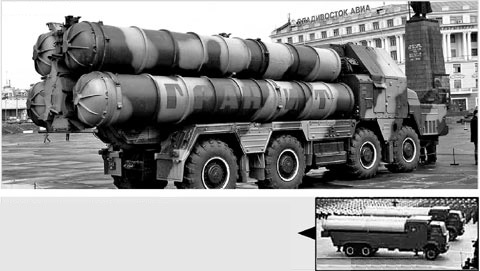
I told ya I'd keep this part pretty simple. If the KN- Series of mobile launchers has anything like the capabilities of what it's based on (The S-300), then it's a big headache. Nothing Kim has is a terminal problem, but it's a headache that could well get some pilots killed.
Unfortunately, this is yet another area where you can ask 10 world experts and you will get at least 6 totally different and unrelated answers for inventory number. None will match and ALL will insist to their dying breath that they are 150% right and the other 5 are flat wrong.
We DO know WHAT they have though, as satellites are always watching. By the very nature of the systems, they cannot hide everything, all the time ....or it's as useless as the museum pieces they bear such a resemblence to.
* Self Propelled AA Guns *
ZSU 23

(Estimated - ? - FAS Graphic)
ZSU - 57

(Estimated - ? - FAS Graphic)
The ZSU's are deviously effective weapons systems, despite their old and low tech appearance. In fact, it's this low tech that gives them their lethality. Next I'll go into AA Missiles and you'll see, those are known by number and to the meter for location. They can't just bounce around on a whim or drive themselves elsewhere over night. The ZSU systems can. Additionally, terrain is all in their favor within North Korea.
Source
Topography: Approximately 80 percent of the land area is made up of mountain ranges
separated by deep, narrow valleys. All mountains on the Korean Peninsula higher than 2,000
meters above sea level are in North Korea. The highest peak, on the northern border with China,
is Paektu-san at 2,744 meters above sea level. There are wide coastal plains on the west coast
and discontinuous coastal plains on the east coast.
The terrain allows them to be sitting under any tree, in any valley they choose among the many thousands of valleys North Korea has. They can power up, fire and power back down, then drive off to a new spot or into a reinforced revetment to hide themselves. In real terms and with one exception, the ZSU is likely the most dangerous of the weapons our pilots will face.
* Anti-Air Missile Batteries *
I'm going to keep this fairly short, because I know this stuff isn't what people care about or want to see about North Korea. What they can send OUT is what has everyone concerned and forms the basis of their threats to the world. Still this is critical to cover because it determines the success of OUR guys in making sure Kim can't send anything out.
Thirty three active and one inactive EW sites provide the DPRK with early warning radar coverage, used for SAM system target acquisition and track handoff, and GCI control of fighter units. These EW sites are primarily consolidated in the southern half of the nation, providing substantial coverage of the capital and the DMZ. Identified EW radars operating in the DPRK are predominately Soviet-era systems
Source
There are currently fifty eight active strategic SAM sites located in the DPRK. The following image depicts the locations of these sites. S-75 sites are red, S-125 sites are light blue, and S-200 sites are purple. As can be seen, the overwhelming majority of the deployed strategic SAM assets are located along the DMZ and the coasts.
These aren't overly important because they are pre-registered targets and would be assigned in advance for destruction within the opening minutes and hours.
North Korea's test launch of a KN-06 surface-to-air missile into the West Sea early this month appears to have been successful, South Korean Defense Minister Kim Kwan-jin said at a hearing by the National Assembly's Defense Committee on Monday.
This changes it a bit and it's close to the Russian S-300 and Chinese variants. This is mobile and far more survivable. It's also a domestic production with unknown numbers.
(Source: N.Korea 'Successfully Test Fired Short-Range Missile')

I told ya I'd keep this part pretty simple. If the KN- Series of mobile launchers has anything like the capabilities of what it's based on (The S-300), then it's a big headache. Nothing Kim has is a terminal problem, but it's a headache that could well get some pilots killed.
Okay, now I get to what I know everyone has REALLY been waiting for. Offensive weapons capability.
In specific terms of his artillery and rocket forces. Northern South Korea lives under both threats.
* Artillery / Rocket Forces *
Popular Mechanics comes in great for descriptions of things. Now lets see where we can see about some numbers?
From USA Today - March 30, 2013:
From the Defense Intelligence Agency:
and finally, from a DOD news release dated October, 2012:
The issue with the above forces isn't a chance North Korea could win. It's the problem that they THINK they can win. That is dangerous in and of itself. Winning for North Korea is simply not a possibility. It's like suggesting Taiwan could not just hold off but DEFEAT Mainland China. The whole notion is absurd.
However, Kim isn't acting entirely rational and he has left even his own allies wondering about his motives and mental state.
The bottom line to this section of weapons is that even in a total victory condition for the ROK and Allied forces? The damage done before getting to that end state is near catastrophic for the South. Mainland America is under no serious threat by anything originating in North Korea (Yes I worded that carefully), but the South will take a pasting, as they say.
In specific terms of his artillery and rocket forces. Northern South Korea lives under both threats.
* Artillery / Rocket Forces *
Heavy Rockets
North Korea has a variety of rockets mounted on trucks, mainly adapted from Russian and Chinese designs. These are direct descendants of the Katyusha or "Stalin Organ" rockets of WWII.
They also developed some new rockets of their own. These are large caliber, 240mm (9.4 inch), and have a range estimated to be at least 25 miles. Each 17-ft-long rocket has a warhead containing about 100 pounds of explosives, though there are reportedly also chemical and incendiary versions. The launchers, which have also been exported Iran, are mounted on a local version of an Isuzu 6x6 truck.
Source
Long-range artillery
The 170mm (6.7") self-propelled gun, designated M1978 or M1987 is also an NK special, thought to have been derived from 1950's Russian coastal guns. The long-barreled weapon is mounted on a tank chassis, and can fire a rocket-assisted shell out to forty miles. When they were introduced in the 1978 they were claimed to have the longest range of any artillery piece in the world. The later version, first seen by Western analysts in 1987 and therefore called the M1987, carries 12 rounds of ammunition on board. The gun is externally mounted, leaving the crew exposed. The North Koreans exported these to Iran, where they saw use during the Iran-Iraq war; like the 240mm rocket launcher, they guns are made by North Korea's Third Machine Industry Bureau.
Popular Mechanics comes in great for descriptions of things. Now lets see where we can see about some numbers?
From USA Today - March 30, 2013:
But North Korean forces are arrayed along the demilitarized zone with 10,000 artillery pieces capable of reaching Seoul, said Bruce Klingner, a former CIA analyst now at the Heritage Foundation.
That proximity would let them cause a lot of casualties and damage in the initial stages of an attack. The North Koreans have about 1.1 million troops in their armed forces. Three-quarters of them are staged within 60 miles of the DMZ, Klingner said.
From the Defense Intelligence Agency:
Source
The most significant development in the ground forces has been the continued deployment of long-range artillery systems (240-mm multiple rocket launchers and 170-mm self-propelled guns) near the DMZ. Although these deployments are not yet complete, the North is continuing production of these long-range systems. The increasing number of long-range artillery systems gives North Korea the ability to provide devastating indirect firepower in support of ground force operations. Pyongyang has deployed over 10,000 artillery systems, an increase of almost 10 percent over the past 15 years, in addition to over 2,300 multiple rocket launchers. Most of the artillery is self-propelled and can support a rapidly moving operation.
and finally, from a DOD news release dated October, 2012:
Source
The South Korean military faces a formidable and unpredictable foe in the North. North Korea maintains the fourth-largest military in the world, and possesses significant conventional and asymmetric capabilities, Thurman said.
With more than 1 million personnel, the North Korean army has more than 13,000 artillery systems, more than 4,000 tanks and more than 2,000 armored personnel carriers. North Korea’s air force has more than 1,700 aircraft, and its navy has more than 800 surface combatants. “And more than 70 percent of this combat power is positioned within 90 miles of the Demilitarized Zone,” Thurman said.
The issue with the above forces isn't a chance North Korea could win. It's the problem that they THINK they can win. That is dangerous in and of itself. Winning for North Korea is simply not a possibility. It's like suggesting Taiwan could not just hold off but DEFEAT Mainland China. The whole notion is absurd.
However, Kim isn't acting entirely rational and he has left even his own allies wondering about his motives and mental state.
The bottom line to this section of weapons is that even in a total victory condition for the ROK and Allied forces? The damage done before getting to that end state is near catastrophic for the South. Mainland America is under no serious threat by anything originating in North Korea (Yes I worded that carefully), but the South will take a pasting, as they say.
Missiles Missiles everywhere but where is one to hit the US? That IS the question. A good question it is, too. Let's explore the facts on this.
Speaking of range.. Here is the chart that shows Missile flight range to different US points.

The above report to Congress also details the purchase of 12 Foxtrot and Golf II class submarines from Russia. The Golf II's ARE capable of carrying SLBM Missiles. Here is another 'it's not that simple' though. They were sold without the firing systems or supporting electronics. No SMALL thing when a 1000 different things can make a ballistic missile do anything but what it's supposed to do.
North Korean Missile Chronology
The above is a report detailing the production and acquisition of missile and offensive capability dating back to the end of the Korean War. It's very informative and if I do add more later on development cycles, it's a significant part to the story. Included here for those who want to read the details. Now... Enough of this boring reading for a moment. Lets see some eye candy, eh?
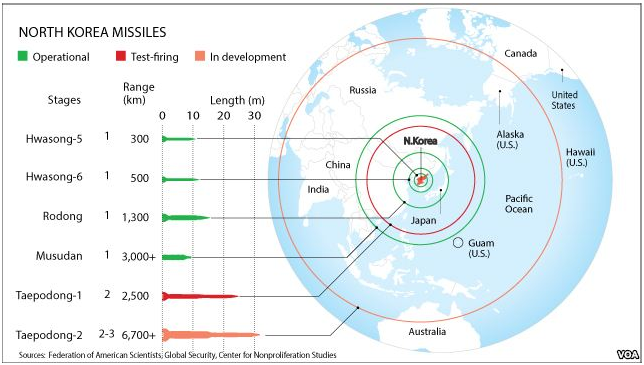
(Source of above graphic and timeline)
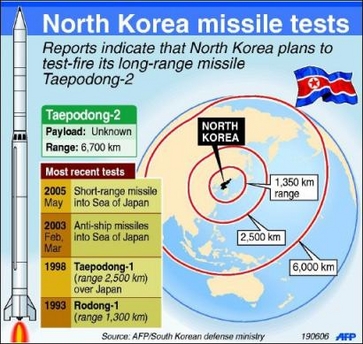
(Source)
Here is a detailed breakdown of each missile type, what they are known for in capability as well as a brief history
An Overview of North Korea's Ballistic Missile Program
As I am not tackling the specific issue of nuclear or chemical weapons this time (Another 4 pages sitting in Word at the moment), I'll leave one more graphic in covering the highlights to watch in any upcoming conflict. This is a graphic depiction for points of interest.
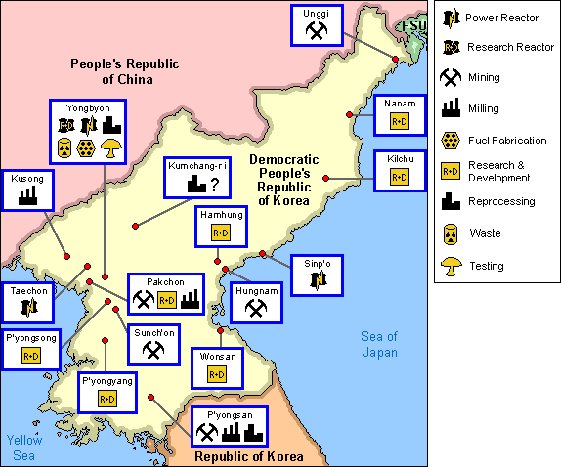
(Source)
The above source not only provides clickable reference to the map points, but a range of links to many sources for the NBC weapons potential in the DPRK.
The North Korean Taepo Dong program traces its origins to the No Dong medium range ballistic missile 1 program of the late 1980s. In the early 1990s, North Korea initiated the development of two ballistic missile programs known to the West as TaepoDong 1 and Taepo Dong 2.2 The supposed design objectives for the Taepo Dong 1 system were to deliver a 1,000 to 1,500 kg warhead to a range of 1,500 to 2,500 km and for the Taepo Dong 2 to deliver the same warhead to a 4,000 to 8,000 km range.
Speaking of range.. Here is the chart that shows Missile flight range to different US points.

For the Taepo Dong 1 to achieve greater
range its payload would have to be decreased. Some analysts speculate that a reduced-payload configuration could deliver a 200 kg warhead into the U.S. center and a 100 kg warhead to Washington D.C., albeit with poor accuracy.15
Source
Some experts voice concern over North Korea’s level of military spending in relation
to its missile program. North Korea reportedly spends as much as 40 percent of its gross
domestic product (GDP) on the military.25 In 2004, U.S. Forces Korea commander,
General Leon J. LaPorte, reportedly stated that North Korea’s military investments are
primarily in their nuclear, biological, chemical and missile programs in order to gain an
“asymmetrical” advantage over U.S and South Korean forces.26
The above report to Congress also details the purchase of 12 Foxtrot and Golf II class submarines from Russia. The Golf II's ARE capable of carrying SLBM Missiles. Here is another 'it's not that simple' though. They were sold without the firing systems or supporting electronics. No SMALL thing when a 1000 different things can make a ballistic missile do anything but what it's supposed to do.
North Korean Missile Chronology
The above is a report detailing the production and acquisition of missile and offensive capability dating back to the end of the Korean War. It's very informative and if I do add more later on development cycles, it's a significant part to the story. Included here for those who want to read the details. Now... Enough of this boring reading for a moment. Lets see some eye candy, eh?
North Korea's nuclear and missile programs
Aug. 1998: Test fires Taepodong-1, its first long-range rocket
Sept. 1999: Pledges to freeze long-range missile tests amid improving U.S. ties
Mar. 2005: Ends moratorium on missile tests, blames "hostile" policy of U.S.
Jul. 5, 2006: Test fires long-range Taepodong-2, which fails after launch
Jul. 15, 2006: U.N. Security Council demands Pyongyang halt missile program
Oct. 9, 2006: Conducts first underground nuclear test
Oct.15, 2006: U.N. Security Council demands halt to missile, nuclear tests, bans sale of weapons
Apr. 5, 2009: Launches long-range rocket that lands in Pacific; U.S. says no satellite placed in orbit
Apr. 13, 2009: U.N. Security Council condemns launch, tightens sanctions; Pyongyang quits six-party nuclear talks
May 2009: Conducts second underground nuclear test
Jun. 2009: Security Council imposes tougher sanctions
Feb. 2012: Announces moratorium on nuclear and long-range missile programs in exchange for U.S. food aid
Apr. 2012: Launches long-range rocket, which falls apart shortly after lift-off
Dec. 2012: Launches Unha-3 rocket, declares success in placing satellite in orbit
Jan. 2013: U.N. Security Council condemns December rocket launch
Feb. 2013: Conducts third nuclear test

(Source of above graphic and timeline)

(Source)
Here is a detailed breakdown of each missile type, what they are known for in capability as well as a brief history
An Overview of North Korea's Ballistic Missile Program
As I am not tackling the specific issue of nuclear or chemical weapons this time (Another 4 pages sitting in Word at the moment), I'll leave one more graphic in covering the highlights to watch in any upcoming conflict. This is a graphic depiction for points of interest.

(Source)
The above source not only provides clickable reference to the map points, but a range of links to many sources for the NBC weapons potential in the DPRK.
edit on 30-3-2013 by Wrabbit2000 because: (no reason given)
Finally, a thread that says it all in one place.
Yes, the US can beat them, if China and Russia allow it, which they will not.
SK would be in ruins after the first 60 minutes of combat.
Can NK win, hell no. Can they inflict a huge amount of damage, hell yes.
Who wins out of this conflict .... China, when she marches in and secures both NK and SK in the name of world peace. What can the US do after that .... nothing, nothing at all. It is China who wants this to explode so she can rid the Asian land mass of direct Western influence.
Wrabbit, well done!
P
Yes, the US can beat them, if China and Russia allow it, which they will not.
SK would be in ruins after the first 60 minutes of combat.
Can NK win, hell no. Can they inflict a huge amount of damage, hell yes.
Who wins out of this conflict .... China, when she marches in and secures both NK and SK in the name of world peace. What can the US do after that .... nothing, nothing at all. It is China who wants this to explode so she can rid the Asian land mass of direct Western influence.
Wrabbit, well done!
P
reply to post by pheonix358
Wrabbit2000, Great thread, S & F
pheonix358, You're Exactly Right, Truer words have not been written.
That would be one of China's long term goals finally coming to past with the idiot in charge now.
Wrabbit2000, Great thread, S & F
Who wins out of this conflict .... China, when she marches in and secures both NK and SK in the name of world peace. What can the US do after that .... nothing, nothing at all. It is China who wants this to explode so she can rid the Asian land mass of direct Western influence.
pheonix358, You're Exactly Right, Truer words have not been written.
That would be one of China's long term goals finally coming to past with the idiot in charge now.
rabbit...
you kinda left out a pretty good heli, 2 uavs, since the us still uses the F-5 you left out the "more than 150" 21's they have... (and the 21s are very capable fighters specially on that terrain at low altitude) and you mentioned a biplane, the antonov labeling it as "stealth" when 1) its a "transport" aircraft not "stealth" and 2) they do have a real antonov transport aircraft which btw is the same that russia still uses today.
Speaking of transport, you missed also the fact that they have A LOT of transport, I'm sure you know what that means... and air superiority is not quite what they have in mind - it only does so much - it takes ground troops to take over like NK wants to - they're objective is to "unify" the koreas, not to obliterate and carpet bomb everything on their path and then have it all silky smooth - its "their" country, they cant act like the US does in other people's countries.
We do know that NK is not really on par with the US BUT you dont need to downplay it so much.
you kinda left out a pretty good heli, 2 uavs, since the us still uses the F-5 you left out the "more than 150" 21's they have... (and the 21s are very capable fighters specially on that terrain at low altitude) and you mentioned a biplane, the antonov labeling it as "stealth" when 1) its a "transport" aircraft not "stealth" and 2) they do have a real antonov transport aircraft which btw is the same that russia still uses today.
Speaking of transport, you missed also the fact that they have A LOT of transport, I'm sure you know what that means... and air superiority is not quite what they have in mind - it only does so much - it takes ground troops to take over like NK wants to - they're objective is to "unify" the koreas, not to obliterate and carpet bomb everything on their path and then have it all silky smooth - its "their" country, they cant act like the US does in other people's countries.
We do know that NK is not really on par with the US BUT you dont need to downplay it so much.
reply to post by Wrabbit2000
Thank You for all the hard work you have put in to bring us such an informative - 'one stop shop' - thread.
The N. Korean military is certainly on paper, capable of causing some major nose bleeds. We can only hope that
the currently spouted rhetoric, is just that - rhetoric.
Hopefully, lil' kim does hold some respect in the eyes of the 'old generals' and can find a way to save face,
after all the blowhard blustering of late.
The impoverished, I guess innocent people of this mighty weird nation, deserve a crack at a real life - in a real world.
Thank You for all the hard work you have put in to bring us such an informative - 'one stop shop' - thread.
The N. Korean military is certainly on paper, capable of causing some major nose bleeds. We can only hope that
the currently spouted rhetoric, is just that - rhetoric.
Hopefully, lil' kim does hold some respect in the eyes of the 'old generals' and can find a way to save face,
after all the blowhard blustering of late.
The impoverished, I guess innocent people of this mighty weird nation, deserve a crack at a real life - in a real world.
Flag and lots of stars!
Wrabbit, this report Linky is the one that scares the crap out of any sane person. When you combine all of the known artillery pieces the North has, combined with their known rate of fire ... well it is nothing to sneeze at.
To be able to reply in say the first hour alone, there has to be someone alive on the SK side of the DMZ. Seoul is within range of about 300 big pieces with a firing rate of 4 rounds per minute. Whatever the numbers, Seoul is in for a crap storm.
Of course the first thing to be hit is any military installation within range. Just as the US knows where some of NK's weapons are, the North sure well knows where everything is in SK. I believe that SK would be a sea of craters out to 40 miles, 64Kilometers from the DMZ.
AN all or nothing attack with the older aircraft would also do a lot of damage before they were shot down. The other thing of note is that older aircraft can carry newer ordinance. A radar homing missile can still take out a defensive battery no matter what aircraft it is fired from.
NK doctrine holds that it does not matter if the aircraft (pilot) are killed as long as it gets its payload delivered in the first strike. If it makes it home ... hey, bonus ... well done fellas. Here ya go, do it again!
The sheer number of just artillery rounds coming down is just staggering and many of these batteries are hidden in tunnels. Yes I know, the US has really big bombs just for this purpose. The question is, do they have enough to do the job.. I don't think they will ever have enough.
If NK fires they will do an awesome amount of damage before they are put down and mark my words, it will NOT be the US that puts them down, it will be China / Russia and I would not be surprised if they work hand in hand to get the West off the Asian land mass. this IS what it is all about.
The slaughter of NK and SK civilians is just the price of all three doing business.
Disgusting, I know.
P
ETA Those old Tanks are a laugh, as tanks. As mobile artillery they are not a laughing matter nor are they a laughing matter as mobile pill boxes! This is the problem when looking at older equipment, you can always find a new role for them. Even if that role is just to draw modern fighters into an AA storm.
Wrabbit, this report Linky is the one that scares the crap out of any sane person. When you combine all of the known artillery pieces the North has, combined with their known rate of fire ... well it is nothing to sneeze at.
To be able to reply in say the first hour alone, there has to be someone alive on the SK side of the DMZ. Seoul is within range of about 300 big pieces with a firing rate of 4 rounds per minute. Whatever the numbers, Seoul is in for a crap storm.
Of course the first thing to be hit is any military installation within range. Just as the US knows where some of NK's weapons are, the North sure well knows where everything is in SK. I believe that SK would be a sea of craters out to 40 miles, 64Kilometers from the DMZ.
AN all or nothing attack with the older aircraft would also do a lot of damage before they were shot down. The other thing of note is that older aircraft can carry newer ordinance. A radar homing missile can still take out a defensive battery no matter what aircraft it is fired from.
NK doctrine holds that it does not matter if the aircraft (pilot) are killed as long as it gets its payload delivered in the first strike. If it makes it home ... hey, bonus ... well done fellas. Here ya go, do it again!
The sheer number of just artillery rounds coming down is just staggering and many of these batteries are hidden in tunnels. Yes I know, the US has really big bombs just for this purpose. The question is, do they have enough to do the job.. I don't think they will ever have enough.
If NK fires they will do an awesome amount of damage before they are put down and mark my words, it will NOT be the US that puts them down, it will be China / Russia and I would not be surprised if they work hand in hand to get the West off the Asian land mass. this IS what it is all about.
The slaughter of NK and SK civilians is just the price of all three doing business.
Disgusting, I know.
P
edit on 31/3/2013 by pheonix358 because: (no reason given)
ETA Those old Tanks are a laugh, as tanks. As mobile artillery they are not a laughing matter nor are they a laughing matter as mobile pill boxes! This is the problem when looking at older equipment, you can always find a new role for them. Even if that role is just to draw modern fighters into an AA storm.
edit on 31/3/2013 by pheonix358 because: (no reason given)
Wow Friend!
Such an informative and well written post!
THIS is why Wrabbit is my fav member. He sets the bar HIGH!
Such an informative and well written post!
THIS is why Wrabbit is my fav member. He sets the bar HIGH!
reply to post by Wrabbit2000
It won't be a colt versus a B2. If NK's president decides to attack anyone it will be the South. He won't go after the US.
NATO will take days or weeks to meet with other nations deciding on how to stop the aggression and arm SK.
Eventually it might be a colt versus a B2, but not before he could create some serious havoc in the South.
Hmmm... A colt Vs a....
It won't be a colt versus a B2. If NK's president decides to attack anyone it will be the South. He won't go after the US.
NATO will take days or weeks to meet with other nations deciding on how to stop the aggression and arm SK.
Eventually it might be a colt versus a B2, but not before he could create some serious havoc in the South.
Originally posted by FraternitasSaturni
rabbit...
you kinda left out a pretty good heli, 2 uavs, since the us still uses the F-5 you left out the "more than 150" 21's they have... (and the 21s are very capable fighters specially on that terrain at low altitude) and you mentioned a biplane, the antonov labeling it as "stealth" when 1) its a "transport" aircraft not "stealth" and 2) they do have a real antonov transport aircraft which btw is the same that russia still uses today.
Speaking of transport, you missed also the fact that they have A LOT of transport, I'm sure you know what that means... and air superiority is not quite what they have in mind - it only does so much - it takes ground troops to take over like NK wants to - they're objective is to "unify" the koreas, not to obliterate and carpet bomb everything on their path and then have it all silky smooth - its "their" country, they cant act like the US does in other people's countries.
We do know that NK is not really on par with the US BUT you dont need to downplay it so much.
Okay, to address your points in explanation, because they are fair things to ask and you might imagine ...editing and trimming was required before I sent it all up. It's always a mixed thing and I think people writing big contributions like this just hope the best as someone might have been watching for, wasn't among what was dropped at the last moment for space.
On the Helicopters ...Which one did I leave out? There is a rather long list of models they have. Inside their nation, they're effective. I probably could have made a page on those alone...but I left off with what I did along with the best known numbers to show sheer scale because they aren't offensive weapons. Strictly defense in this situation as they won't GET the chance to be offensive with airpower that I can see.
I did see mention of a UAV. Unknown specific type and unknown capability for the report I read. I left that out for the vagueness. It was so general, it could have been a Reaper or a model toy. Without being able to present more? Well...
On the Stealth Biplane. I had a bit of fun there, but if you read the background and source, it explains the reasoning that they DO actually see it that way. It's low, slow and with the ability to run under radar. Actually, it's a very clever thing to do, given how low tech can outsmart the super-high tech radar nets sometimes. It's sole purpose, by what I read, was the delivery of Special Forces to points south of the DMZ in advance of the opening shots. In that way, it's actually required to live up to it's pressed purpose.
Transports were interesting for a topic and I considered it, as all I'll say overall about content which may not have appeared. It didn't come in, as a specific reason because they aren't weapons platforms and will have survivability measured in minutes from take off unless the Aegis systems off shore deliberately ALLOW them to fly longer. I think Kim's helicopters can play peek-a-boo in the valleys and canyons and quite possibly survive multiple flights that way. Anything like a transport which has to fly above the ridgelines? Well.... I hope the DPRK gives outstanding benefits to pilot's families if this all happens. Those poor guys are sitting ducks in a shooting gallery.
Sorry that some of what you'd wanted didn't get into the final version I posted, and I do mean that. I aimed to be as complete as I could without writing a book ...which I pretty much did anyway ...but I had to put some limits somewhere, right? lol..
reply to post by pheonix358
Agreed. China being a major US trading partner and a member of the UN Security Council and with historic ties to the peninsula would be the one to move in and rebuild. Incidentally growth in China has stagnated and they are itching to build elsewhere (re-build in this case - post war).
Agreed. China being a major US trading partner and a member of the UN Security Council and with historic ties to the peninsula would be the one to move in and rebuild. Incidentally growth in China has stagnated and they are itching to build elsewhere (re-build in this case - post war).
reply to post by FraternitasSaturni
The AN-2 does have some degree of stealth, due to the wood and fabric construction. It's like the Mosquito in WWII. Besides the propeller (which granted is a decent sized radar return), not a lot for a radar to bounce off of. (This part is directed to you, the rest is general information)
But the DPRK helicopter forces include the Mi-24D, which is dangerous in many ways, the MD-500D, which in the configuration bought is a scout, but can have light weapons added easily, Mi-8, Mi-17.
For transports/heavy lift, they have the Il-76 (roughly the equivalent of the old C-141 in the US), the AN-24 (at least one converted to AEW using the N019 MiG-29 radar), Il-62, and the Z-5. They even have a handful of Li-2s, which are reverse engineered (by the Soviets) DC-3s.
They have two known UAV programs right now. One is the Tu-143, the other is the MQM-107 from the US. They got their hands on an MQM-107D, and reverse engineered it, and made it remote control. The -107 in the US is simply a target drone for live fire exercises.
There's a lot more detail to go into, but when dealing with OOB, you can take up 10 pages before you blink. The core of the fighter fleet is made up of MiG-15/17/21s all of which flew around the time of the first Korean War. The MiG-21 was the first with a rudimentary radar system installed. The MiG-15, at the time was nothing to sneeze at, but is beyond obsolete at this point, in fact all three are. What North Korea has going for them is sheer numbers when it comes to the fighters. If they can keep the Wolfpack (the US F-16 squadron in Seoul) occupied with their fighters, they can use their Il-76s and AN-24s to scatter troops all over the South. If they were willing to risk it, they could even load up their Il-62s and crash land them around the country. You can fit 200 into an Il-62 in a normal configuration. If you really pack them in, you could at least double that number.
The AN-2 does have some degree of stealth, due to the wood and fabric construction. It's like the Mosquito in WWII. Besides the propeller (which granted is a decent sized radar return), not a lot for a radar to bounce off of. (This part is directed to you, the rest is general information)
But the DPRK helicopter forces include the Mi-24D, which is dangerous in many ways, the MD-500D, which in the configuration bought is a scout, but can have light weapons added easily, Mi-8, Mi-17.
For transports/heavy lift, they have the Il-76 (roughly the equivalent of the old C-141 in the US), the AN-24 (at least one converted to AEW using the N019 MiG-29 radar), Il-62, and the Z-5. They even have a handful of Li-2s, which are reverse engineered (by the Soviets) DC-3s.
They have two known UAV programs right now. One is the Tu-143, the other is the MQM-107 from the US. They got their hands on an MQM-107D, and reverse engineered it, and made it remote control. The -107 in the US is simply a target drone for live fire exercises.
There's a lot more detail to go into, but when dealing with OOB, you can take up 10 pages before you blink. The core of the fighter fleet is made up of MiG-15/17/21s all of which flew around the time of the first Korean War. The MiG-21 was the first with a rudimentary radar system installed. The MiG-15, at the time was nothing to sneeze at, but is beyond obsolete at this point, in fact all three are. What North Korea has going for them is sheer numbers when it comes to the fighters. If they can keep the Wolfpack (the US F-16 squadron in Seoul) occupied with their fighters, they can use their Il-76s and AN-24s to scatter troops all over the South. If they were willing to risk it, they could even load up their Il-62s and crash land them around the country. You can fit 200 into an Il-62 in a normal configuration. If you really pack them in, you could at least double that number.
reply to post by Miracula
If won't matter if he goes after the US or not. Our treaty obligation is that if the South is attacked, we respond with them.
If won't matter if he goes after the US or not. Our treaty obligation is that if the South is attacked, we respond with them.
reply to post by Wrabbit2000
Ofc... its not like you have to spend nights just writing the "bible of nk military" but...
well... the "21s" are the Migs of course (more than 150). Since the US still keeps their F-5s too...
The UAVs are 2... the Tupolev Tu-143 and the MQM-107
The helicopter is the infamous mi 24 - How on earth could you leave this one out? Its the mi 24 rabbit! come on!! That bird alone deserves respect! Its in everyone's coldwar nightmares
Ofc... its not like you have to spend nights just writing the "bible of nk military" but...
well... the "21s" are the Migs of course (more than 150). Since the US still keeps their F-5s too...
The UAVs are 2... the Tupolev Tu-143 and the MQM-107
The helicopter is the infamous mi 24 - How on earth could you leave this one out? Its the mi 24 rabbit! come on!! That bird alone deserves respect! Its in everyone's coldwar nightmares
We won't get hurt I have a tried, and proven solution.
First we help start this war, go all out with a WW3 scenario.
Then step back, and just build weapons, and sell them.
Then when its raining dollars in the good 'ol US of A step in
at last minute, and save the day! Its fool proof!!
Nice thread I had fun reading, now to scare the crap out of whoever will listen.
First we help start this war, go all out with a WW3 scenario.
Then step back, and just build weapons, and sell them.
Then when its raining dollars in the good 'ol US of A step in
at last minute, and save the day! Its fool proof!!
Nice thread I had fun reading, now to scare the crap out of whoever will listen.
Here is an interesting read with North Korean Military Tactics against the USA as well as there military hardware and capabilites.
rense.com...
rense.com...
Originally posted by FraternitasSaturni
Since the US still keeps their F-5s too...
Yeah, but the F-5 won't ever see combat again. It makes a wonderful MiG simulator though for Top Gun, and other exercises, and the Aggressor squadrons love them (until they finally get their new toys, whatever those turn out to be).
new topics
-
This is adorable you guys!
General Chit Chat: 6 hours ago -
Reprehensible Behavior
US Political Madness: 7 hours ago -
Defending the need for adherence to Old Testament commandments under the new covenant of Christ
Conspiracies in Religions: 8 hours ago
top topics
-
Reprehensible Behavior
US Political Madness: 7 hours ago, 10 flags -
Those Drones over NJ and elsewhere
Aliens and UFOs: 12 hours ago, 8 flags -
South Korean coup was an attempt to start WW3
World War Three: 12 hours ago, 7 flags -
This is adorable you guys!
General Chit Chat: 6 hours ago, 7 flags -
Archer aviation and the NJ drones
Aircraft Projects: 13 hours ago, 5 flags -
Defending the need for adherence to Old Testament commandments under the new covenant of Christ
Conspiracies in Religions: 8 hours ago, 5 flags
active topics
-
Defending the need for adherence to Old Testament commandments under the new covenant of Christ
Conspiracies in Religions • 11 • : randomuser2034 -
Drones everywhere in New Jersey ---and Elsewhere Master Thread
Aliens and UFOs • 171 • : nugget1 -
Post A Funny (T&C Friendly) Pic Part IV: The LOL awakens!
General Chit Chat • 7912 • : imitator -
This is adorable you guys!
General Chit Chat • 4 • : CriticalStinker -
The Acronym Game .. Pt.4
General Chit Chat • 1016 • : FullHeathen -
Could rampant land speculation have caused the Civil War?
History • 35 • : matafuchs -
George Stephanopoulos and ABC agree to pay $15 million to settle Trump defamation suit
Mainstream News • 23 • : Brotherman -
Pelosi injured in Luxembourg
Other Current Events • 45 • : rickymouse -
Nov 2024 - Former President Barack Hussein Obama Has Lost His Aura.
US Political Madness • 19 • : Connector -
Sky Intruders - Drones, Deception & One Weird UFO Video : Weaponizes : Episode #62
Aliens and UFOs • 7 • : DontTreadOnMe
